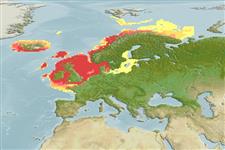Environment: milieu / climate zone / depth range / distribution range
Ecology
Marine; demersal; depth range 0 - 270 m (Ref. 58496). Temperate; 4°C - 8°C; 77°N - 43°N, 28°W - 46°E
Northeast Atlantic: English Channel to Finmarken and Murman coasts and White Sea, also the Shetlands, the Faroes and southern and southwestern coasts of Iceland; southern part of Baltic.
Size / Weight / Age
Maturity: Lm ? range ? - ? cm
Max length : 21.0 cm TL male/unsexed; (Ref. 4700); common length : 14.0 cm TL male/unsexed; (Ref. 4700); max. reported age: 3.00 years (Ref. 722)
Dorsal spines (total): 5 - 6; Dorsal soft rays (total): 6 - 8; Anal soft rays: 5 - 7. Unpaired breast row of plates absent, but paired plate rows cover whole breast. Snout with a pair of strong spiny hooks; numerous barbels on branchiostegal membranes. Dorsal plates 31-34 (Ref. 232). Spiny and soft dorsal fins almost fused. No spines on the hind part of the head (Ref. 35388).
Inhabits inshore waters, deeper waters in winter in Skaggerak, preferring sandy bottoms, rarely with stones. Maximum depth reported at 270 m (Ref. 28197). Temp. range: 4.0-8.0 °C. Feeds on bottom crustaceans and polychaetes. Matures after about 1 year; a few spawning in the second year (Ref. 722). The eggs are laid in seaweed (Ref. 9900). Spawns in February - April, female laying 2,500-3,000 yellow eggs with a diameter of 2 mm. Period of development is very long and 6-8 mm long pelagic larvae hatch after 10-11 months (Ref. 35388).
Ehrenbaum, E., 1936. Naturgeschichte und wirtschaftliche Bedeutung der Seefische Nordeuropas. Handb. Seefisch. Nordeurop. 2:337 p. (Ref. 40)
IUCN Red List Status (Ref. 130435: Version 2024-2)
Threat to humans
Harmless
Human uses
Fisheries: of no interest; aquarium: public aquariums
Tools
Special reports
Download XML
Internet sources
Estimates based on models
Preferred temperature (Ref.
123201): 7 - 11.7, mean 9.2 °C (based on 442 cells).
Phylogenetic diversity index (Ref.
82804): PD
50 = 1.0000 [Uniqueness, from 0.5 = low to 2.0 = high].
Bayesian length-weight: a=0.01023 (0.00395 - 0.02652), b=2.98 (2.76 - 3.20), in cm total length, based on LWR estimates for this (Sub)family-body shape (Ref.
93245).
Trophic level (Ref.
69278): 3.4 ±0.3 se; based on diet studies.
Generation time: 2.3 ( na - na) years. Estimated as median ln(3)/K based on 1
growth studies.
Resilience (Ref.
120179): Medium, minimum population doubling time 1.4 - 4.4 years (K=0.47; tm=1-4; tmax=3; Fec=2,400).
Fishing Vulnerability (Ref.
59153): Low to moderate vulnerability (26 of 100).
Nutrients (Ref.
124155): Calcium = 66.7 [36.3, 143.8] mg/100g; Iron = 0.486 [0.257, 0.865] mg/100g; Protein = 17.4 [16.0, 18.8] %; Omega3 = 1.1 [0.5, 3.1] g/100g; Selenium = 14.9 [7.8, 33.6] μg/100g; VitaminA = 18.4 [5.7, 55.2] μg/100g; Zinc = 0.681 [0.485, 0.986] mg/100g (wet weight);
